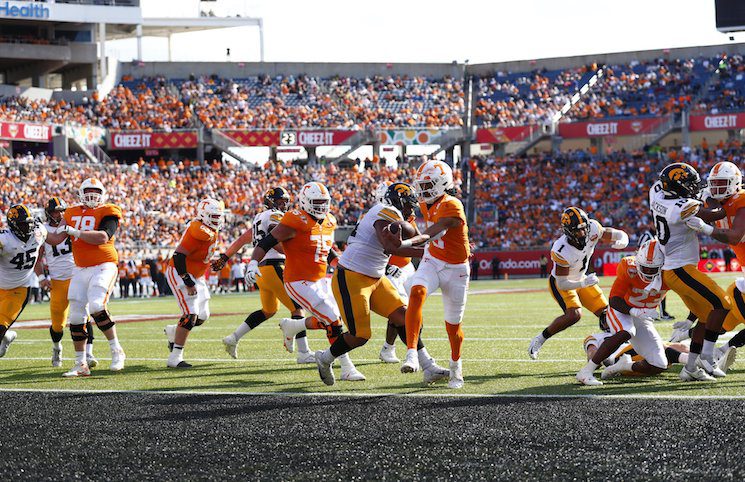
When Tennessee’s men’s basketball team has played their best this season, it’s been because they’ve attacked the paint and didn’t get complacent on offense. The Vols were best when Grant Williams and Admiral Schofield drove in the lane and drew fouls, and they played the most efficient when Williams and UT’s post players were the emphasis and the ball movement by the whole team was fluid.
But in all four of Tennessee’s losses this year, there’s been a common theme: Settling.
On Saturday, the Vols settled for jumpers and three-pointers time and time again against Auburn, and that played right into the Tigers’ hands. Tennessee ended up playing Auburn’s style of basketball rather than their own, and the Tigers wound up getting the victory, 84-80.
Saturday’s game against Auburn wasn’t the only time that’s been an issue for the Vols, though.
In Tennessee’s four losses this season, the common threads in all of them have been the Vols shooting more three-pointers than they usually do and UT’s opponents getting to the foul line far more often than the Vols.
Tennessee head coach Rick Barnes said as much on Monday during his press conference.
“It goes back to the other three losses we’ve had this year. They’ve pretty much played out the same way with too many threes, not getting to the foul line enough,” Barnes stated. “There’s a big discrepancy if you look at our four losses in terms of how little we got to the free throw line and how many threes that we took that were really shots we shouldn’t be taking to be quite honest, at least without probing and trying to get fouled.
“There’s a discrepancy in what our opponents shot at the free throw line and what we did. There’s a big discrepancy, and that’s from settling for threes when you shouldn’t.”
Barnes is right; in Tennessee’s four losses this season, the Vols have been severely out-shot at the free throw line, and their three-point attempts are much higher in those four games than their 27 wins.
Against Kansas back in late November, the Vols attempted just 17 free throws compared to 34 by the Jayhawks. In the Vols’ loss to Kentucky in February, the Wildcats attempted 33 free throws compared to UT’s 18. LSU got to the line 31 times compared to just 16 by the Vols, and Auburn shot 24 free throws compared to Tennessee’s 16.
In those four losses, the Vols have been out-shot at the free throw line 122 to 67. That’s almost double the amount of free throws for UT’s opponents than what the Vols themselves shot in those games.
Grant Williams himself was able to get to the free throw line a decent amount in all of those contests, as he accounted for 35 of UT’s 67 free throw attempts in those four games, giving him an average of 8.8 free throw attempts. But that means the rest of Tennessee’s team only averaged eight free throws a game in those four games. For a team that prides itself on being physical and attacking the basket, that’s inexcusable.
The lack of an aggressive mentality is further emphasized when you look at Tennessee’s shot selection in those games as well.
Tennessee averaged 25.5 attempted three-pointers in their four losses in the regular season. The Vols shot over 20 threes in all four of those games, and their three-point attempts accounted for 38.9 percent of their overall shots.
In the Vols’ 27 wins this season, they averaged 18.3 threes a game and only took 20 or more threes in 12 contests. Tennessee’s three-point shots accounted for just 30.9 percent of their total field goals in those 27 games.
The Vols could get away with that kind of strategy against inferior opponents. Tennessee got out-shot at the free throw line against teams like Texas A&M, Florida, and Louisiana this year, yet the Vols won those contests.
But when the Vols played the more talented teams on their schedule, that’s when that approach became an issue.
Kansas, Kentucky, LSU, and Auburn were four of the most talented teams the Vols faced this season, and in those four losses, Tennessee got lulled into settling for threes and jumpers rather than trying to attack the rim. There isn’t a better example of what UT is capable of when playing that way vs. when they play their brand of basketball than their two contests against Kentucky this season.
In the Vols’ first game against the Wildcats, they were beaten soundly and weren’t allowed to play their style of basketball. Tennessee only made it to the free throw line 18 times and shot 25 three-pointers. Those threes accounted for 42.4 percent of their total field goal attempts. Kentucky, meanwhile, shot 33 free throws and only took 13 threes.
When the two teams met in Knoxville, the Vols did a better job of not settling. They still got out-shot at the free throw line 29-14, but it wasn’t because they weren’t attacking the basket. Tennessee only took 22 threes and had their three-point attempts account for just 35.5 percent of their field goals attempts.
Lamonte Turner has taken a lot of heat from fans lately because they view him as “shooting the Vols out of games” at times and being more selfish. While Turner is certainly in a prolonged slump right now (1 for his last 15 threes and just 3 for his last 26 threes), he hasn’t been shooting more this season than he did last year. Last season, Turner averaged 5.1 three-point attempts per game, and he’s averaging 5.5 threes a game this season.
The difference between last year and this year is that Turner isn’t making threes right now. He’s hitting just 29.5 percent of his shots from distance compared to making 39.5 percent of his threes last year.
Turner’s inability to hit threes has been an issue, but he’s not the only one who’s at fault in UT’s four losses this season.
In the four games the Vols have lost this year, Admiral Schofield hasn’t been as aggressive as he usually is and has settled for jumpers and threes far too often. In Tennessee’s 27 wins, three-pointers make up only 34.7 percent of Schofield’s overall field goal attempts, and he’s averaging just 4.5 three-pointers a game. But in UT’s four losses, Schofield is averaging 6.3 three-point attempts, and those shots make up 35.2 percent of his shot selection.
It’s simple: When Jordan Bone is aggressive and the offense runs through him cutting to the basket, Grant Williams gets plenty of opportunities, and Admiral Schofield attacks the rim rather than settling for jumpers, then the Vols are one of the top teams in college basketball.
If Tennessee settles for threes and isn’t driving to the basket, though, then they’re beatable by teams that are good enough to make them pay.



